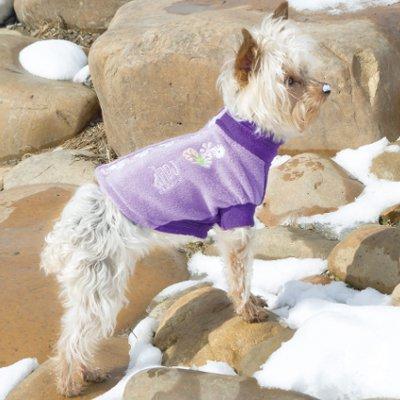When the temperature drops, people pull on sweaters. Dogs and cats don't have the benefit of pulling something out of the closet to wear. While Texas winters tend to be mild, abrupt changes in the weather often leave pets shivering in shock. So, does your pet need a sweater? The answer is--it depends.
Fur Protection and Pet Preference
Magic-the-wooly-wonder would spend hours outside if he had his choice. But Seren and Karma are both heat-seeking cats. They prefer dozing in puddles of sunshine and a draft sends them scurrying for shelter.
For pets that spend most or all of their time outdoors, or that are equipped with a naturally thick weather resistant double-coat, forego the sweater. Northern dog breeds like Huskies and Malamutes were bred to withstand cold and even relish it.
Reasons to NOT Give Pets A Sweater
Not only would it be difficult to keep the sweater or coat clean and dry, but an extra layer may reduce or slow fur growth so important to outdoor animals. Acclimating pets gradually to outdoor chills stimulates their fur to grow thicker and be more protective.
A wet sweater is worse than no sweater at all. Dry fur can be elevated (piloerection) to trap warm air next to the skin and insulate your pet. A coat that gets wet holds the cold next to the dog or cat's body, and can increase the loss of body eat.
 Prime Sweater Candidates
Prime Sweater Candidates
Exclusively indoor pets as well as those with short coats won't be as well equipped to spend time outside, so be aware and bring them back inside after only short trips to the bathroom and back. These are the dogs and cats that may benefit from sweater, whether they go outside or shiver inside during winter weather. Aging dogs and cats are less cold tolerant as they age, because they lose muscle and fat mass that insulates, increases their metabolism and keeps them warm. Aging skin and fur also tends to get thinner.
Little dogs have less body mass to generate natural heat, too. Small dogs benefit the most from a doggy sweater especially when they must do outdoor bathroom duty. While cats may benefit from sweater wearing, they rarely appreciate this type of attention.
Getting Dogs Ready for Sweaters
Many of the same tips used for dressing pets up for Halloween apply to prepping your dogs and cats to wear cold weather clothes. Dogs that are shivery already may be delighted to discover sweater wearing, while others take a bit of persuasion.
Pet sweaters and coats should be fitted the same as for children. Make sure it doesn't restrict movement, vision, hearing or ability to breathe. Measure your pet's girth around the neck, chest and waist and look for specifics on the clothes sizing for an accurate fit.
Start by simply letting your dog sniff and examine the material. Set it out on the floor, point it out to him, and offer some tasty treats when he sniffs it. Do this for the first half a day. After he associates the sweater or coat with treats, drape part of the material over his back for 10 seconds. Again praise and treat him for calm behavior. Increase the amount of time it's left on his back, giving him a treat and praise each time. Repeat this for at least two days.
The third day, put the sweater on for the first time. Let him roll around, sniff, and explore how it feels to move, all the while encouraging him with treats and praise. Take it off after a minute, and put away the treats.
Put the costume back on half a dozen times, leaving it on a bit longer each time, and offering plenty of treats and praise. Encourage him to walk around while wearing it, so he knows that it doesn't restrict movement. When you take the costume off, the treats should go away.
Continue practicing wearing the coat or sweater for longer and longer periods of time. Once your pet no longer seems bothered by it, you're ready for a trip outside wearing the winter gear.
What About Booties?
There are doggy booties available for dogs. While foot gear seems to be a reasonable protection for dogs, be cautious about providing these for your dog. Breeds that were bred to work in the snow usually do best "bare footed" so that they have better traction. And dogs that are not meant to spend long periods outdoors probably won't need booties.
Dogs that may benefit from booties may be canine athletes that work in sled dog teams or other winter sports. The same recommendations apply for measuring and fitting the equipment appropriately, and gradually getting your dog used to the gear.
For other dogs, be paw-aware. Check paws when your dog comes inside, to clean off any ice balls that tend to form in the fur between the pads. Also, guide your dog when outside to avoid areas treated with salt or other de-icing agents, and rinse the feet when they come inside.
Dog sweaters and coats help keep chilly dogs warm and safe. And for those that relish dressing up, it can also be a fun bonding experience, not to mention fashion statement!


